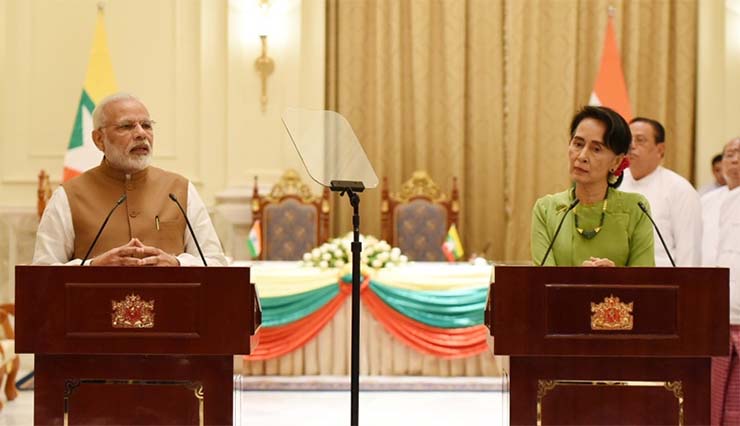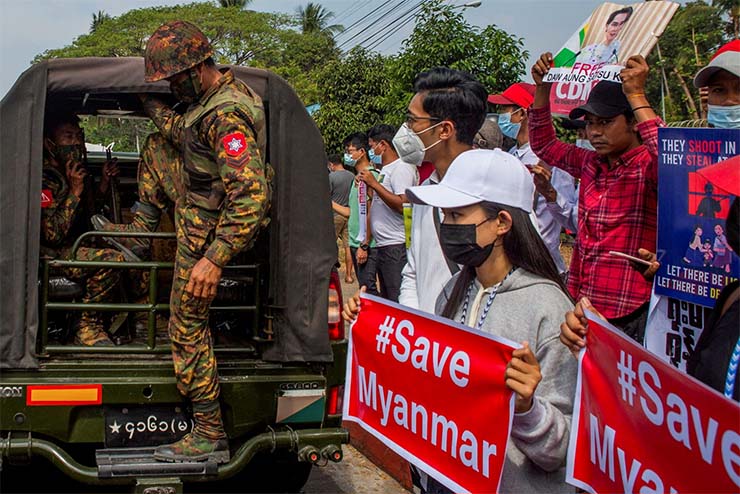
Burma née Myanmar (1989 onwards) gained independence just months after the Indian independence on 4 January 1948. However, it has traversed a tumultuous political road since them.
Two significant forces, which have been key active players in Myanmar’s political landscape, are the Buddhist monks and the Myanmar army. Myanmar’s Buddhist monks have followed a long tradition of political, often anti-authority activism, from the anti-colonial movements of the 1930s to uprisings against the military rule in 1988 and 2007. Many opposed the 2021 military coup, with some even abandoning their robes to take up arms against the junta.
But some monks have worked with the generals too, sharing with them a belief that both Buddhism and Burmese culture need defending from outside influences.
Following violent clashes between local Buddhists and Muslim Rohingyas in Rakhine State in 2012, one militant monk, Wirathu, helped set up a movement known as Ma Ba Tha, or the Association for Protection of Race and Religion. It encouraged a boycott of Muslim-owned (Rohingyas) businesses, claiming that Burmese Buddhism was in danger of being wiped out by Muslims. Though Muslims make up just 8% of Myanmar’s population. The movement was officially disbanded in 2017, but has continued to enjoy covert military support.
The Tatmadaw (Myanmar’s military junta), Min Aung Hlaing’s coup in February 2021 provoked a huge public backlash, with massive rallies demanding a return to democratic rule, which were brutally put down. The 67-year-old general has since sought to bolster his legitimacy by presenting himself as a champion of Buddhism.
However, this marriage between the army and the monks doesn’t last long, and a part of an ultra-nationalist fringe of the Buddhist clergy, which has until now been staunchly behind the military junta, led by monk Pauk Ko Taw, is asking for replacing Min Aung Hlaing by his deputy General Soe Win.
Two significant forces, which have been key active players in Myanmar’s political landscape, are the Buddhist monks and the Myanmar army
Since then, Myanmar’s military regime recently extended its state of emergency for another six months as it marked three years on 1 February, of its deadly coup which ousted democratically elected leader Aung San Suu Kyi.
After the start of Operation 1027, an on-going military offensive conducted by the Three Brotherhood Alliance, a military coalition composed of three ethnic armed organisations in Myanmar: the Arakan Army (AA), Myanmar National Democratic Alliance Army (MNDAA), and Ta’ang National Liberation Army (TNLA), allied with other rebel forces in the country, against the Tatmadaw, and has mounted the most significant escalation in hostilities since the army uprising.
Analysts say that the military is at its weakest since the coup, with some even suggesting its imminent collapse. But alongside resistance gains, there has been a serious humanitarian cost. From 26 October to 8 December, more than 578,000 people were displaced on top of nearly 2 million who were already displaced before the surge in fighting according to the United Nations, which said 363 civilians had been killed and 461 injured since late October 2021.
India-Myanmar Ties
India’s 1,600 km (990 miles) long border with Myanmar, forces it to walk a tightrope while engaging with the Myanmar military to pursue its geostrategic objectives. These objectives include maintaining peace and stability in India’s northeast.
 The Indian states of Mizoram, Manipur, Nagaland and Arunachal Pradesh in Northeast India share border with Kachin State, Sagaing Region and Chin State in Myanmar. In addition to the long land border, India and Myanmar also share a maritime border with India’s Andaman Islands.
The Indian states of Mizoram, Manipur, Nagaland and Arunachal Pradesh in Northeast India share border with Kachin State, Sagaing Region and Chin State in Myanmar. In addition to the long land border, India and Myanmar also share a maritime border with India’s Andaman Islands.
In 2013, India provided a loan of about US$ 500 million to Myanmar for its development; India and Myanmar have also agreed to cooperate militarily in order to help modernise Myanmar’s military. In 2020, India gifted the Myanmar navy its first ever submarine, a kilo class (INS Sindhuvir) attack submarine which has been refurbished and modernised by Hindustan Shipyard Limited.
The Tatmadaw’s coup in February 2021 provoked a huge public backlash, but the junta has since sought to bolster its legitimacy by presenting itself as a champion of Buddhism
Indian and Myanmar troops carried out jointly, Operation Sunrise and Operation Sunrise 2 in 2019, in their respective territories to destroy several insurgent camps. However, the threat to the Kaladan multi-modal transit transport project, India’s gateway to Southeast Asia continues.
India has also supported Myanmar in its efforts to combat Rohingya insurgent groups like the Arakan Rohingya Salvation Army (ARSA) and Aqa Mul Mujahideen (AMM), after Indian intelligence agencies found the ARSA and AMM to have links with terror groups like the Lashkar-e-Taiba (LeT) and Jaish-e-Mohammed (JeM) as well as reported Rohingya terrorists fighting alongside Pakistani extremists in Kashmir.
Obviously, India was hesitant in reacting to the 2007 Burmese anti-government protests that had drawn overwhelming international condemnation. India also declared that it had no intention of interfering in Burma’s internal affairs and that the Burmese people would have to achieve democracy by themselves as it respects the sovereignty of Myanmar. This low-key response was widely criticised both within India and abroad as weakening India’s credentials as a leading democratic nation.
After the start of Operation 1027, an on-going military offensive conducted by the Three Brotherhood Alliance, against the Tatmadaw, Myanmar has seen the most significant escalation in hostilities since the army uprising
In contrast to much of the international community, Prime Minister Modi declined to criticise Suu Kyi’s handling of the 2016-17 Northern Rakhine State clashes or Myanmar’s government’s treatment of its Rohingya people.
India also announced plans to deport its Rohingya refugee population. Minister of State for Home Affairs Kiren Rijiju described the refugees as ‘illegal immigrants’, echoing the Myanmar government’s position.
India’s Concerns
On the one hand India has to ensure peace and security in its northeastern region, but in its policy towards Myanmar, it is also guided by its economic objectives. In addition, India also wants to counter the Chinese sphere of influence in Myanmar. In that sense China has maintained strategic, defence and economic ties with Myanmar much longer as compared to India.
Concerns and tensions have increased in India over China’s extensive military involvement in developing ports, naval and intelligence facilities and industries, specifically the upgrading of a naval base in Sittwe, a major seaport located close to the eastern Indian city of Kolkata.
India’s long border with Myanmar, forces it to walk a tightrope while engaging with the Myanmar military to pursue its geostrategic objectives. The paramount objective is to maintain peace and stability in India’s northeast
On its part China has announced that it would back the Myanmar regime no matter how the situation changes, indicating Beijing’s desire to deepen exchanges and cooperation with Naypyitaw, which is of concern to India.
Myanmar also falls under China’s Belt and Road Initiative with a $100 billion economic corridor connecting the Chinese province of Yunnan with oil and gas fields in Rakhine state.
On the other hand, India’s engagement with the Myanmar’s military junta has helped ease the regime’s international isolation and lessen its dependence and affinity on China. Both nations sought to cooperate to counteract drug trafficking and insurgent groups operating in the border areas. India and Myanmar are leading members of BIMSTEC and the Mekong-Ganga Cooperation, along with Vietnam, Laos, Cambodia and Thailand, helping India develop its influence and ties amongst Southeast Asian nations.
This support for the junta might have sprung from the fact that India has to act in a very cautious manner while dealing with refugee influx from Myanmar into India. These refugees are not just Rohingya Muslims but also Christian Mizos.
Indian support for the junta might have sprung from the fact that India has to act in a very cautious manner while dealing with refugee influx from Myanmar into India. These refugees are not just Rohingya Muslims but also Christian Mizos
Several northeastern Indian tribes such as the Mizos, Kukis, Nagas and Zomis, which consist of several smaller groups, share close ties across the border. It is mostly tribes living along the Mizoram-Myanmar and Manipur-Myanmar borders that are involved in the refugee crisis. Most refugees coming in from Chin are from Lai, Tedim-Zomi, Luse, Hualngo and Natu tribes, which share close links with the Mizos of Mizoram, as well as the Kuki-Zomis of Manipur.
Over the decades, many residents of the Chin state have migrated to Mizoram. The numbers were especially significant after the crackdown on pro-democracy protests by the Tatmadaw in 1988.
In an interview with Deutsche Welle, Isaac Khen of the Prime Minister’s Office of the National Unity Government (NUG) said that it looks as if India is trying to stay neutral in the current political context of Myanmar but it is not the correct decision. Khen added that it is observed that India’s Myanmar policy is directly related to the policy of China in Myanmar and it (India) is still weak to support pro-democracy actors in Myanmar.
The NUG is the shadow government that was formed to oppose the military in mid-April 2021, comprising a group of elected lawmakers and members of parliament to oppose the junta and setup a democratically elected government in Myanmar.
In a nutshell it could be said that so far India’s policy towards Myanmar has been very cautious due to play and counter-play of several ethnic, political and economic issues. But overall India should not let its guard down, as maintaining peace in its northeast is of crucial importance to India, besides promoting trade in the ASEAN region through its economic corridors with Myanmar, to counter China’s BRI are also important. Though India has always canvassed for a civilian rule in Myanmar, yet it also has to ensure that the flame of armed conflicts in Myanmar doesn’t reach its north-eastern states.
–The writer is a political commentator based in New Delhi. He can be contacted on www.asadmirza.in. The views expressed are of the writer and do not necessarily reflect the views of Raksha Anirveda















